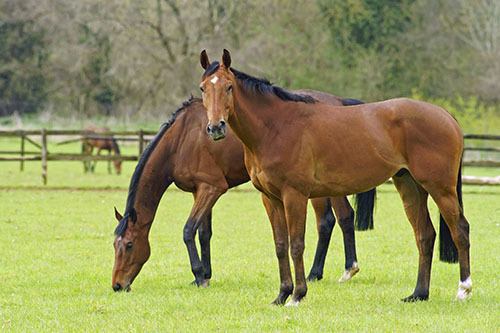Rehabilitating Horses
May 25, 2021

Equine rehabilitation is a dauting task. It is important to know that the steps and tips to rehabilitating and reconditioning horses depends are their status when you begin. Check out these tips to use when working with horses depending on their specific needs.
Rehabilitating a Starved Horse
The first step in rehabilitating a starved or neglected horse is to consult with a veterinarian to identify the reason for weight loss and identify health concerns that may affect the rehabilitation process.
Second is to understand the body condition of the horse. A numerical scale of body condition scores (BCS) on a scale of 1 to 9 is used to assess body condition and fat deposition in horses. Fat deposition is evaluated at six locations in horses: along the neck, withers, topline, tailhead, ribs, and behind the shoulder. A score of BCS of 1 is described as poor, or extremely emaciated while a BCS of 9 represents an extremely obese horse.
A BCS of 2 is described as very thin, BCS of 3 as thin, and BCS of 4 as moderately thin. Scores of 5 and 6 are desirable in most healthy horses.
Feeding the Skinny Horse
A neglected or starved horse (BCS of 1 or 2) should be introduced to feed slowly to allow the microbial populations in the gut an opportunity to rebuild.
Offer the hay at a rate of 1 percent of body weight per day (approximately 10 pounds/day for a 1,000 pound horse), dividing the total amount over four to five small meals each day. Gradually increase the amount of hay provided so that the horse has unlimited access to hay by two weeks of feeding.
A pelleted feed like Co-op’s Winner’s Cup Advantage 1400 (#321) also works well because of its higher level of protein (14%) and increased digestibility.
A condition called refeeding syndrome can occur if the horse is fed too many calories too quickly. This can lead to heart, kidney, or respiratory failure and is caused by the sudden introduction of high levels of carbohydrates and nutrients in the diet.
Feeding the Recovered Horse
Once the horse reaches a body condition score of 5, start adjusting the amount of concentrate fed to maintain a body condition of 5. At this point, it is possible to begin light work with the horse, however be sure to monitor condition and adjust feed or exercise intensity to maintain ideal body condition.
Once the horse has recovered, plan on feeding a minimum of 1 percent of body weight as forage per day (hay or pasture). Forage quality and level of exercise intensity will dictate what kind of concentrate or grain is needed in the diet.
Consult your local Co-op or Grey Parks, TFC Equine Specialist for additional help with your horse’s diet.
For more content like this, check out the latest issue of the Cooperator.
Rehabilitating a Starved Horse
The first step in rehabilitating a starved or neglected horse is to consult with a veterinarian to identify the reason for weight loss and identify health concerns that may affect the rehabilitation process.
Second is to understand the body condition of the horse. A numerical scale of body condition scores (BCS) on a scale of 1 to 9 is used to assess body condition and fat deposition in horses. Fat deposition is evaluated at six locations in horses: along the neck, withers, topline, tailhead, ribs, and behind the shoulder. A score of BCS of 1 is described as poor, or extremely emaciated while a BCS of 9 represents an extremely obese horse.
A BCS of 2 is described as very thin, BCS of 3 as thin, and BCS of 4 as moderately thin. Scores of 5 and 6 are desirable in most healthy horses.
Feeding the Skinny Horse
A neglected or starved horse (BCS of 1 or 2) should be introduced to feed slowly to allow the microbial populations in the gut an opportunity to rebuild.
- Start with forage.
Offer the hay at a rate of 1 percent of body weight per day (approximately 10 pounds/day for a 1,000 pound horse), dividing the total amount over four to five small meals each day. Gradually increase the amount of hay provided so that the horse has unlimited access to hay by two weeks of feeding.
- What about feeding a grain or concentrate?
- What type of grain or concentrate should I use?
A pelleted feed like Co-op’s Winner’s Cup Advantage 1400 (#321) also works well because of its higher level of protein (14%) and increased digestibility.
- Always offer water
- How long will it take to see a difference?
- What challenges can I expect?
A condition called refeeding syndrome can occur if the horse is fed too many calories too quickly. This can lead to heart, kidney, or respiratory failure and is caused by the sudden introduction of high levels of carbohydrates and nutrients in the diet.
Feeding the Recovered Horse
Once the horse reaches a body condition score of 5, start adjusting the amount of concentrate fed to maintain a body condition of 5. At this point, it is possible to begin light work with the horse, however be sure to monitor condition and adjust feed or exercise intensity to maintain ideal body condition.
Once the horse has recovered, plan on feeding a minimum of 1 percent of body weight as forage per day (hay or pasture). Forage quality and level of exercise intensity will dictate what kind of concentrate or grain is needed in the diet.
Consult your local Co-op or Grey Parks, TFC Equine Specialist for additional help with your horse’s diet.
For more content like this, check out the latest issue of the Cooperator.